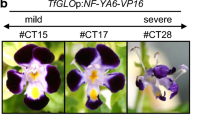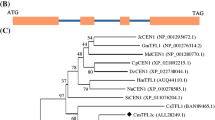Abstract
Key message
TFL1homologCorcanTFL1suppresses the initiation of inflorescence development and regulates the inflorescence morphology inCornus canadensis.
Abstract
In flowering plants, there is a wide range of variation of inflorescence morphology. Despite the ecological and evolutionary importance, efforts devoted to the evolutionary study of the genetic basis of inflorescence morphology are far fewer compared to those on flower development. Our previous study on gene expression patterns suggested a CorTFL1–CorAP1 based model for the evolution of determinate umbels, heads, and mini dichasia from elongated inflorescences in Cornus. Here, we tested the function of CorcanTFL1 in regulating inflorescence development in Cornus canadensis through Agrobacterium-mediated transformation. We showed that transgenic plants overexpressing CorcanTFL1 displayed delayed or suppressed inflorescence initiation and development and extended periods of vegetative growth. Transgenic plants within which CorcanTFL1 had been down-regulated displayed earlier emergence of inflorescence and a reduction of bract and inflorescence sizes, conversions of leaves to bracts and axillary leaf buds to small inflorescences at the uppermost node bearing the inflorescence, or phyllotaxy changes of inflorescence branches and leaves from decussate opposite to spirally alternate. These observations support an important role of CorcanTFL1 in determining flowering time and the morphological destinies of leaves and buds at the node bearing the inflorescence. The evidence is in agreement with the predicted function of CorTFL1 from the gene expression model, supporting a key role of CorTFL1 in the evolutionary divergence of inflorescence forms in Cornus.




Similar content being viewed by others
References
Ahn JH, Miller D, Winter VJ et al (2006) A divergent external loop confers antagonistic activity on floral regulators FT and TFL1. EMBO J 25:605–614
Amasino RM, Michaels SD (2010) The timing of flowering. Plant Physiol 154:516–520
Berbel A, Ferrándiz C, Hecht V et al (2012) VEGETATIVE1 is essential for development of the compound inflorescence in pea. Nat Commun 3:797
Bradley D, Carpenter R, Copsey L et al (1996) Control of inflorescence architecture in Antirrhinum. Nature 379:791
Chang S, Puryear J, Cairney J (1993) A simple and efficient method for isolating RNA from pine trees. Plant Mol Biol Rep 11:113–116
Chery (2016) RNA therapeutics: RNAi and antisense mechanisms and clinical applications. Postdoc J 4(7):35–50
Conti L, Bradley D (2007) TERMINAL FLOWER1 is a mobile signal controlling Arabidopsis architecture. Plant Cell 19:767–778
Feng CM, Qu R, Zhou LL et al (2009) Shoot regeneration of dwarf dogwood (Cornus canadensis L.) and morphological characterization of the regenerated plants. Plant Cell Tissue Organ Cult 97:27–37. https://doi.org/10.1007/s11240-009-9495-0
Feng C, Xiang QJ, Franks RG (2011) Phylogeny-based developmental analyses illuminate evolution of inflorescence architectures in dogwoods (Cornus s.l., Cornaceae). New Phytol 191:850–869
Feng CM, Liu X, Yu Y et al (2012) Evolution of bract development and B-class MADS box gene expression in petaloid bracts of Cornus s. l. (Cornaceae). New Phytol 196:631–643. https://doi.org/10.1111/j.1469-8137.2012.04255.x
Gallavotti A, Barazesh S, Malcomber S et al (2008) sparse inflorescence1 encodes a monocot-specific YUCCA-like gene required for vegetative and reproductive development in maize. Proc Natl Acad Sci USA 105:15196–15201
Hanano S, Goto K (2011) Arabidopsis TERMINAL FLOWER1 is involved in the regulation of flowering time and inflorescence development through transcriptional repression. Plant Cell 23:3172–3184
Höfgen R, Willmitzer L (1988) Storage of competent cells for Agrobacterium transformation. Nucleic Acids Res 16:9877
Irish VF, Sussex IM (1990) Function of the apetala-1 gene during Arabidopsis floral development. Plant Cell 2:741–753
Itoh J, Hibara K, Kojima M et al (2012) Rice DECUSSATE controls phyllotaxy by affecting the cytokinin signaling pathway. Plant J 72:869–881
Johansson M, Staiger D (2015) Time to flower: interplay between photoperiod and the circadian clock. J Exp Bot 66:719–730. https://doi.org/10.1093/jxb/eru441
Kardailsky I, Shukla VK, Ahn JH et al (1999) Activation tagging of the floral inducer FT. Science 286:1962–1965. https://doi.org/10.1126/science.286.5446.1962
Leibfried A, To JPC, Busch W et al (2005) WUSCHEL controls meristem function by direct regulation of cytokinin-inducible response regulators. Nature 438:1172
Liljegren SJ, Gustafson-Brown C, Pinyopich A et al (1999) Interactions among APETALA1, LEAFY, and TERMINAL FLOWER1 specify meristem fate. Plant Cell 11:1007–1018
Lipardi C, Wei Q, Paterson BM (2001) RNAi as random degradative PCR: siRNA primers convert mRNA into dsRNAs that are degraded to generate new siRNAs. Cell 107:297–307
Lippman ZB, Cohen O, Alvarez JP et al (2008) The making of a compound inflorescence in tomato and related nightshades. PLoS Biol 6:e288
Liu J, Franks R, Feng CF et al (2013a) Characterization of the sequence and expression pattern of LFY homologs from dogwoods species (Cornus L.) with divergent inflorescence architectures. Ann Bot 112:1629–1641. https://doi.org/10.1093/aob/mct202
Liu X, Feng C-M, Franks R et al (2013b) Plant regeneration and genetic transformation of C. canadensis: a non-model plant appropriate for investigation of flower development in Cornus (Cornaceae). Plant Cell Rep 32:77–87
Liu X, Zhang J, Abuahmad A et al (2016) Analysis of two TFL1 homologs of dogwood species (Cornus L.) indicates functional conservation in control of transition to flowering. Planta 243:1129–1141
Liu X, Li L, Xiang QY(J) (2017) Down regulation of APETALA3 homolog resulted in defect of floral structure critical to explosive pollen release in Cornus canadensis. JSA 55:566–580
Ma Q, Liu X, Franks RG, Xiang QY(J) (2017) Alterations of CorTFL1 and CorAP1 expression correlate with major evolutionary shifts of inflorescence architecture in Cornus (Cornaceae)–a proposed model for variation of closed inflorescence forms. New Phytol 216:519–535
Mandel MA, Gustafson-Brown C, Savidge B, Yanofsky MF (1992) Molecular characterization of the Arabidopsis floral homeotic gene APETALA1. Nature 360:273
Mimida N, Goto K, Kobayashi Y et al (2001) Functional divergence of the TFL1-like gene family in Arabidopsis revealed by characterization of a novel homologue. Genes Cells 6:327–336
Moyroud E, Minguet EG, Ott F et al (2011) Prediction of regulatory interactions from genome sequences using a biophysical model for the Arabidopsis LEAFY transcription factor. Plant Cell 23:1293–1306
Murashige T, Skoog F (1962) A revised medium for rapid growth and bio assays with tobacco tissue cultures. Physiol Plant 15:473–497
Périlleux C, Lobet G, Tocquin P (2014) Inflorescence development in tomato: gene functions within a zigzag model. Front Plant Sci 5:121
Phillips KA, Skirpan AL, Liu X et al (2011) vanishing tassel2 encodes a grass-specific tryptophan aminotransferase required for vegetative and reproductive development in Maize. Plant Cell 23:550–566
Pnueli L, Carmel-Goren L, Hareven D et al (1998) The SELF-PRUNING gene of tomato regulates vegetative to reproductive switching of sympodial meristems and is the ortholog of CEN. and TFL1. Development 125:1979–1989
Pnueli L, Gutfinger T, Hareven D et al (2001) Tomato SP-interacting proteins define a conserved signaling system that regulates shoot architecture and flowering. Plant Cell 13:2687–2702
Prusinkiewicz P, Erasmus Y, Lane B et al (2007) Evolution and development of inflorescence architectures. Science 316:1452–1456. https://doi.org/10.1126/science.1140429
Ratcliffe OJ, Amaya I, Vincent CA et al (1998) A common mechanism controls the life cycle and architecture of plants. Development 125:1609–1615
Romera-Branchat M, Andrés F, Coupland G (2014) Flowering responses to seasonal cues: what’s new? Curr Opin Plant Biol 21:120–127
Saurabh S, Vidyarthi AS, Prasad D (2014) RNA interference: concept to reality in crop improvement. Planta 239:543–564
Shannon S, Meeks-Wagner DR (1991) A mutation in the Arabidopsis TFL1 gene affects inflorescence meristem development. Plant Cell Online 3:877–892. https://doi.org/10.1105/tpc.3.9.877
Wagner D (2017) Key developmental transitions during flower morphogenesis and their regulation. Curr Opin Genet Dev 45:44–50
Wang R, Albani MC, Vincent C et al (2011) Aa TFL1 confers an age-dependent response to vernalization in perennial Arabis alpina. Plant Cell 23:1307–1321
Wang Z, Yang R, Devisetty UK et al (2017) The divergence of flowering time modulated by FT/TFL1 is independent to their interaction and binding activities. Front Plant Sci 8:697
Weigel D, Alvarez J, Smyth DR et al (1992) LEAFY controls floral meristem identity in Arabidopsis. Cell 69:843–859
Wellmer F, Riechmann JL (2010) Gene networks controlling the initiation of flower development. Trends Genet 26:519–527
Wickland DP, Hanzawa Y (2015) The FLOWERING LOCUS T/TERMINAL FLOWER1 gene family: functional evolution and molecular mechanisms. Mol Plant 8:983–997
Winter CM, Austin RS, Blanvillain-Baufume S et al (2011) LEAFY target genes reveal floral regulatory logic, cis motifs, and a link to biotic stimulus response. Dev Cell 20:430–443
Zhao Z, Andersen SU, Ljung K et al (2010) Hormonal control of the shoot stem-cell niche. Nature 465:1089
Acknowledgements
We would like to thank NCSU Phytotron for providing the space of culturing C. canadensis source plants and transgenic plants. We are grateful to Ron Qu for discussion in vector construction and transformation experiments, to Ashley Yow for participating DNA extraction, to Na Li and Sarah Yim for assistance in culturing the plants in Phytotron, and to the anonymous reviewers for critical review of the manuscript and constructive comments. The study was supported by a National Science Foundation of the United States Grant (IOS-1024629).
Author information
Authors and Affiliations
Corresponding authors
Additional information
Communicated by Baochun Li.
Publisher’s Note
Springer Nature remains neutral with regard to jurisdictional claims in published maps and institutional affiliations.
Electronic supplementary material
Below is the link to the electronic supplementary material.
299_2019_2369_MOESM3_ESM.tif
Fig. S1 WT Cornus canadensis plants. a) Shoot termination and inflorescence development. b) An inflorescence with expanding bracts and opening flowers Supplementary material 3 (TIF 5928 KB)
299_2019_2369_MOESM4_ESM.tif
Fig. S2 Inflorescence morphology of transgenic plants. a) Morphology of inflorescences in a plant downregulating CorcanTFL1 by hairpin construct, supporting figure 4. b) Upregulation of CorcanLFY in leaves of transgenic plants derived from the transformation of CorcanLFY overexpression. c-d) Morphology of inflorescences of plants overexpressing CorcanLFY. The procedure of vector construction for CorcanLFY overexpression is the same as that of vector pH2GW7-CorcanTFL1w Supplementary material 4 (TIF 9143 KB)
Rights and permissions
About this article
Cite this article
Liu, X., Zhang, J., Xie, D. et al. Functional characterization of Terminal Flower1 homolog in Cornus canadensis by genetic transformation. Plant Cell Rep 38, 333–343 (2019). https://doi.org/10.1007/s00299-019-02369-2
Received:
Accepted:
Published:
Issue Date:
DOI: https://doi.org/10.1007/s00299-019-02369-2




